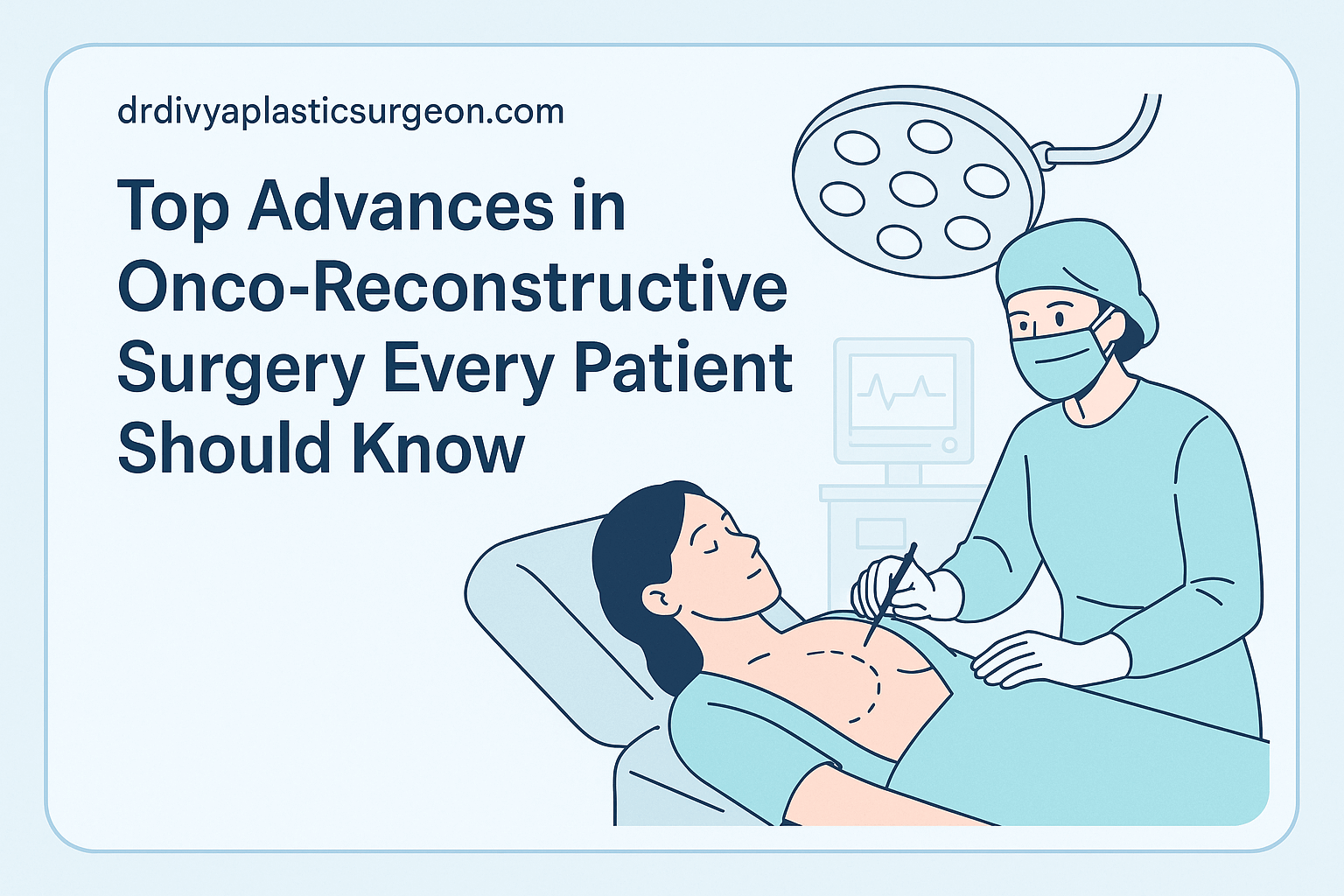
Top Advances in Onco-Reconstructive Surgery Every Patient Should Know

Top Advances in Onco-Reconstructive Surgery Every Patient Should Know
Cancer treatment has evolved beyond just removing tumors — it’s now about restoring form, function, and confidence. Onco-reconstructive surgery plays a crucial role in helping patients heal both physically and emotionally after cancer.
Today’s medical advancements allow surgeons to perform procedures that minimize scars, preserve body function, and improve aesthetics more than ever before.
In this article, we’ll explore the top advances in onco-reconstructive surgery every patient should know before starting their recovery journey.
1. What Is Onco-Reconstructive Surgery?
Onco-reconstructive surgery combines oncology (cancer treatment) and plastic reconstructive surgery.
The goal is to:
- Remove cancer completely, and
- Reconstruct the affected area to restore appearance and function.
This approach is most commonly applied in breast, head and neck, skin, and limb cancers.
2. The Shift Toward Oncoplastic Techniques
Traditionally, cancer surgeries prioritized tumor removal, sometimes compromising aesthetics.
Modern oncoplastic techniques integrate cosmetic principles into cancer surgery — especially in breast cancer cases.
Benefits include:
- Better breast symmetry
- Minimal visible scarring
- Improved emotional recovery
- Preservation of nipple and skin (where medically safe)
Techniques like skin-sparing and nipple-sparing mastectomies are transforming how reconstruction is approached.
3. Microsurgery and Flap Advances
Microsurgical reconstruction has revolutionized outcomes for patients after cancer removal.
Surgeons now use tissue flaps (skin, fat, or muscle) from other parts of the body to reconstruct the affected area.
Popular Flap Types:
- DIEP Flap (Deep Inferior Epigastric Perforator): Uses skin and fat from the abdomen while preserving muscles.
- TRAM Flap: Uses part of abdominal muscle and fat for breast reconstruction.
- Latissimus Dorsi Flap: Utilizes tissue from the back for natural breast shape.
Microsurgery ensures better blood flow, tissue survival, and natural-looking results.
4. 3D Printing and Custom Implants
The introduction of 3D printing in onco-reconstruction has enabled:
- Custom-designed implants that match patient anatomy perfectly
- Improved symmetry and shorter surgery time
- Predictable results with advanced planning software
3D modeling helps surgeons visualize the defect and design precise reconstructions before surgery even begins.
5. Regenerative Medicine and Stem Cell Therapy
Regenerative techniques like fat grafting and stem cell therapy are being used to enhance healing and improve outcomes.
Benefits include:
- Faster tissue recovery
- Reduced scarring
- Improved skin texture and elasticity
- Natural appearance restoration
Fat grafting can also correct contour irregularities and enhance soft-tissue volume after reconstruction.
6. Nerve-Sparing and Sensory Restoration
One of the most significant recent developments is the focus on restoring sensation post-surgery.
Through nerve coaptation (nerve reconnection) techniques, surgeons can now help restore feeling in reconstructed areas — especially in breast reconstruction cases.
This advancement adds a new dimension of functionality and emotional well-being for patients.
7. Minimally Invasive and Robotic Techniques
Robotic-assisted surgery has made onco-reconstruction less invasive and more precise.
Surgeons can now perform:
- Smaller incisions
- Precise tumor removal
- Enhanced accuracy in reconstruction
This results in reduced pain, faster recovery, and minimal scarring.
8. Multidisciplinary Approach in Modern Cancer Care
Modern onco-reconstruction is not just about surgical expertise — it’s about teamwork.
A multidisciplinary approach involving oncologists, plastic surgeons, radiologists, and psychologists ensures:
- Comprehensive treatment planning
- Optimized timing between cancer removal and reconstruction
- Better overall patient satisfaction
9. Psychological and Aesthetic Benefits
The advances in reconstructive techniques have not only improved outcomes but also boosted self-esteem and quality of life.
Restoring physical appearance helps patients regain their identity and emotional strength after cancer.
10. Future of Onco-Reconstructive Surgery
The future promises even more innovation:
- Artificial intelligence (AI) for pre-surgical planning
- Bioprinting of tissues using patient cells
- Enhanced scar management with laser and peptide-based healing
These technologies aim to make recovery even more natural and faster for patients worldwide.
Frequently Asked Questions (FAQs)
1. When is the best time to have reconstructive surgery after cancer?
In many cases, reconstruction can be done immediately after tumor removal (immediate reconstruction).
2. Is onco-reconstructive surgery safe for all cancer patients?
Yes, when planned correctly with your oncologist and reconstructive surgeon. A detailed evaluation ensures cancer removal and reconstruction can be safely performed together.
3. How long is the recovery period?
Recovery varies based on the type of reconstruction. For flap surgeries, it may take 4–8 weeks, while implant-based procedures may recover faster.
4. Will reconstruction affect cancer detection in the future?
No. Modern imaging techniques allow doctors to monitor for recurrence even after reconstruction.
5. Does insurance cover onco-reconstructive surgery?
In India, most health insurance plans do cover reconstructive surgeries post-cancer, as they are considered part of essential cancer care.
Conclusion
Onco-reconstructive surgery has evolved into a sophisticated, patient-centered specialty that focuses on restoring life after cancer.
Thanks to innovations like microsurgery, 3D implants, and regenerative therapies, patients today can achieve exceptional results — both medically and emotionally.
At Dr. Divya Plastic Surgeon, we combine precision, compassion, and advanced surgical techniques to help patients regain their confidence and quality of life after cancer.
